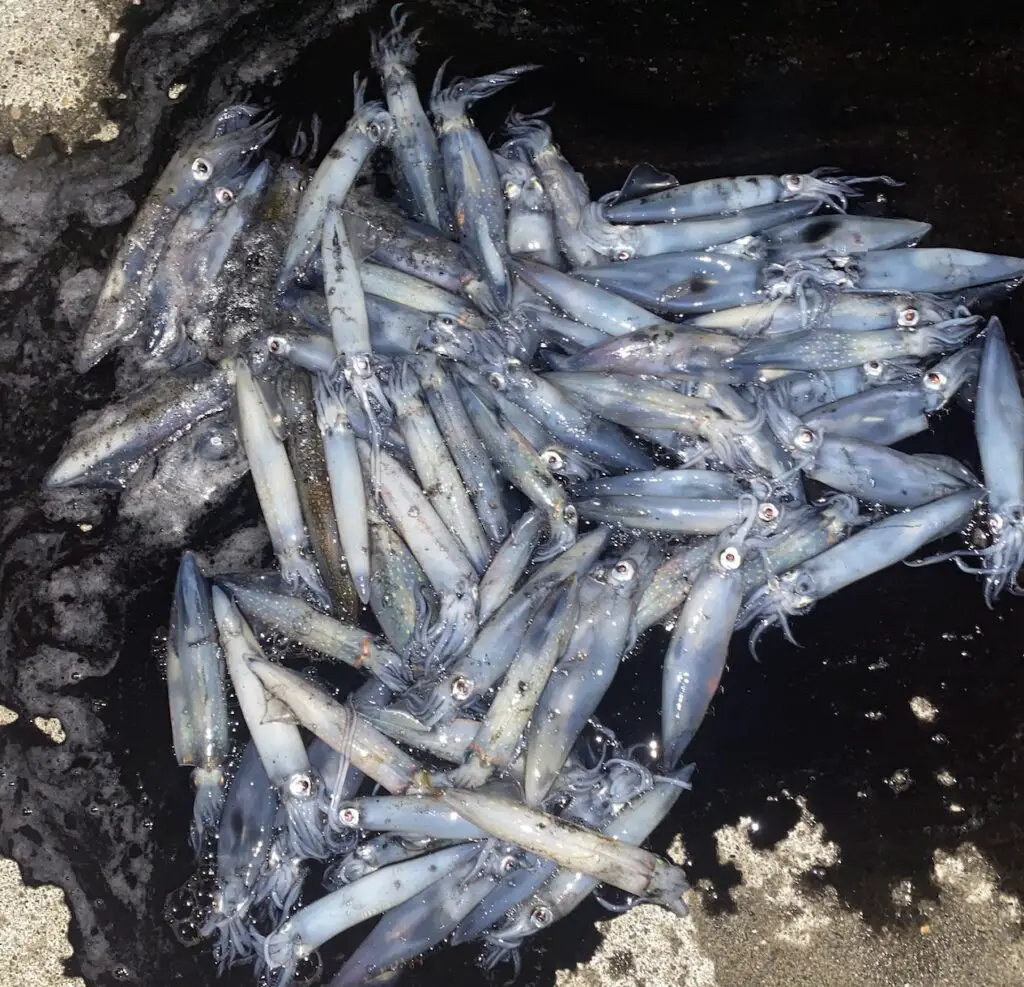
I was recently invited to a squid fishing trip (squid party!) on a boat out of Edmunds, WA and the experience was phenomenal! I’m far from an expert on squidding in Puget Sound, but as always I will share what I learned and what I think are the keys to success.
First of all here’s the setup…we had a high tide around 5:30pm and the mindset of the trip was that we would find squid quickly after nightfall around the public fishing pier a stones throw from the marina.
This didn’t quite work out. A popular boating strategy for catching squid is just anchor up on the edges of schools that move in close to the public fishing pier. You can tell very quickly whether the school is in by watching what the pier fisherman are doing.
And in this case we could see nobody was catching any squid on the pier. After anchoring and dropping our squid jigs for a little bit with no success either, we cruised around the area to try to mark squid on the fish finder.
We came up empty.
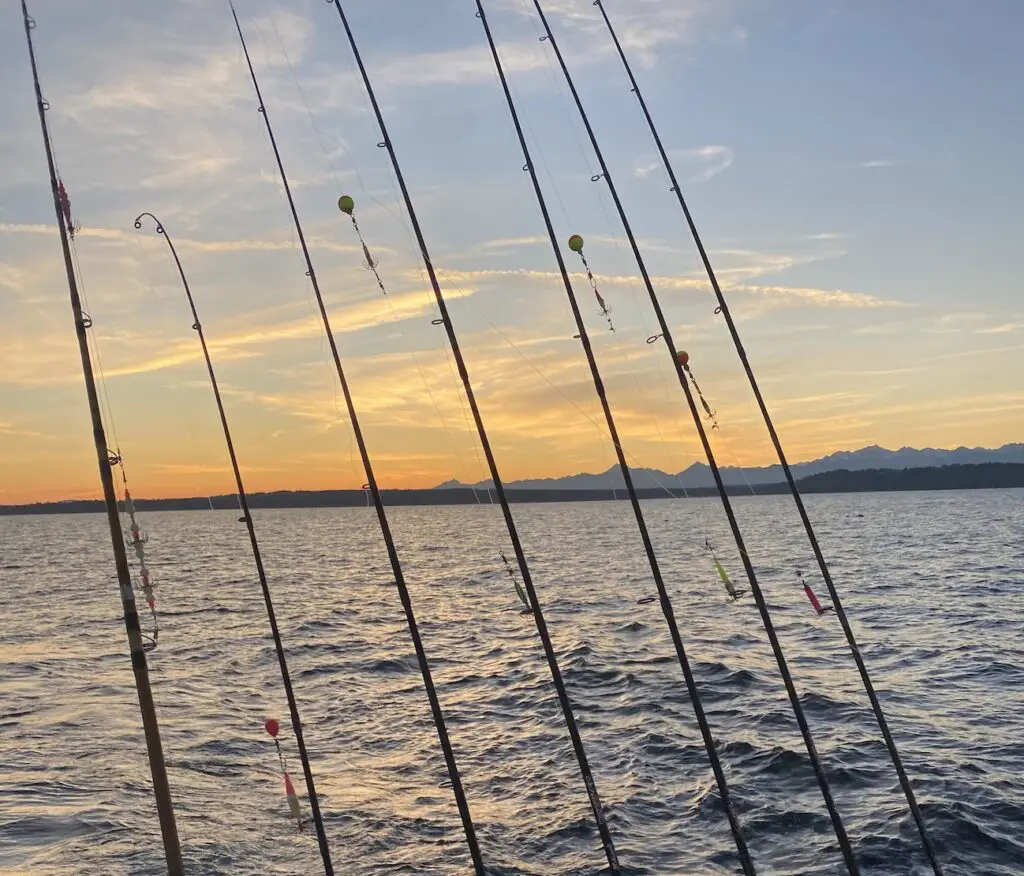
There are some places around Puget Sound that are fishing great on incoming tide during the daytime, but daytime squid success can still be spotty at times. In our case, we were not lucky enough to get into squid right off the jump as the sun was going down.
We motored off to a few places to see if we could a decent school, and that yielded exactly one squid…Not great!
Now it’s about 8pm and the ebb tide is really picking up steam.
We went back to the public fishing pier area and saw immediately folks were getting squid. There were a few other boats drifting around, but they didn’t look like they were on the school.
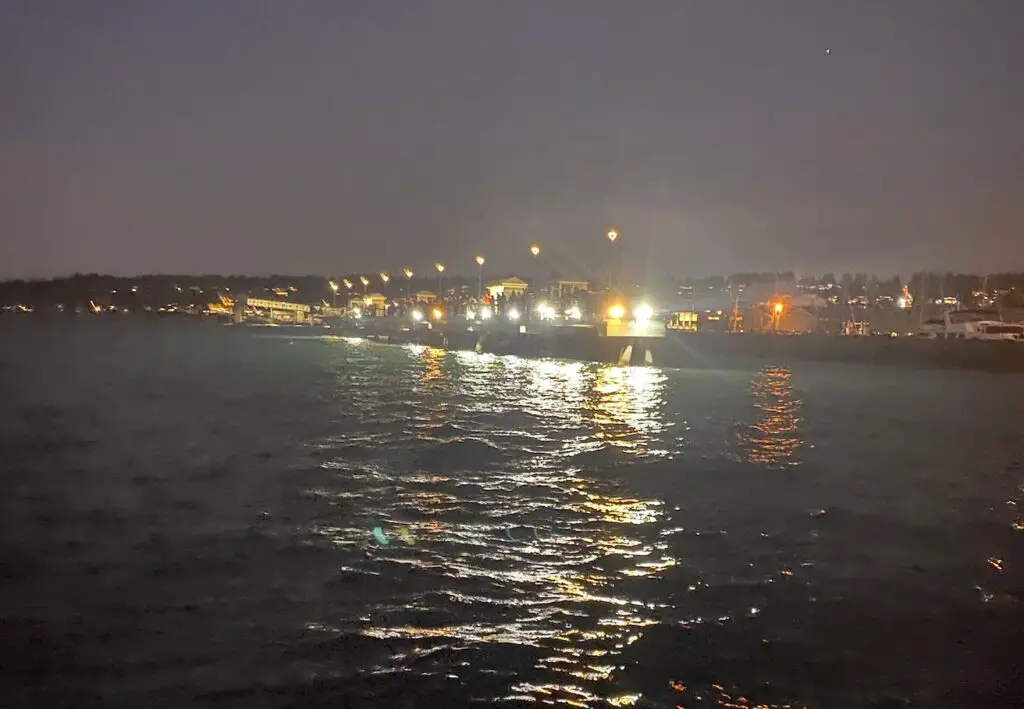
We anchored up again, outside the fishing pier (you never want to be too close!) and deployed a robust light setup to try to bring some squid closer to our boat. We were in about 70 ft of water.
Again, no luck!
And of course, now that we were committed, the pier seemed to completely stop catching squid as well.
We kept grinding and jigging in hopes of getting a few.
The other boats took off, folks on the pier started to disperse. Those in-the-know seemed to have concluded that this wasn’t the night for squid jigging success.
The boat captain of our squid boat is a fine fellow I met through social media and we’ve been out a few times prior to this trip.
On this trip, including me there were 7 of us total. To say that we were all having a good time at this squid party would be an understatement.
The getting skunked squid trip had been an absolute blast up to this point.
I’m not usually a very sociable person. I’m an introvert who likes to hang with familiar people, and I only knew the captain and one other person, but I felt like by the end of the trip I would fish with any of these folks in a heartbeat. They were really a fun group of people!
And then it happened!
I kept glancing at the fish finder while my squid jig setup fluttered throughout the water column. And finally I saw what I had hoped to see, the elongated horizontal lines that denote squid on the fish finder!
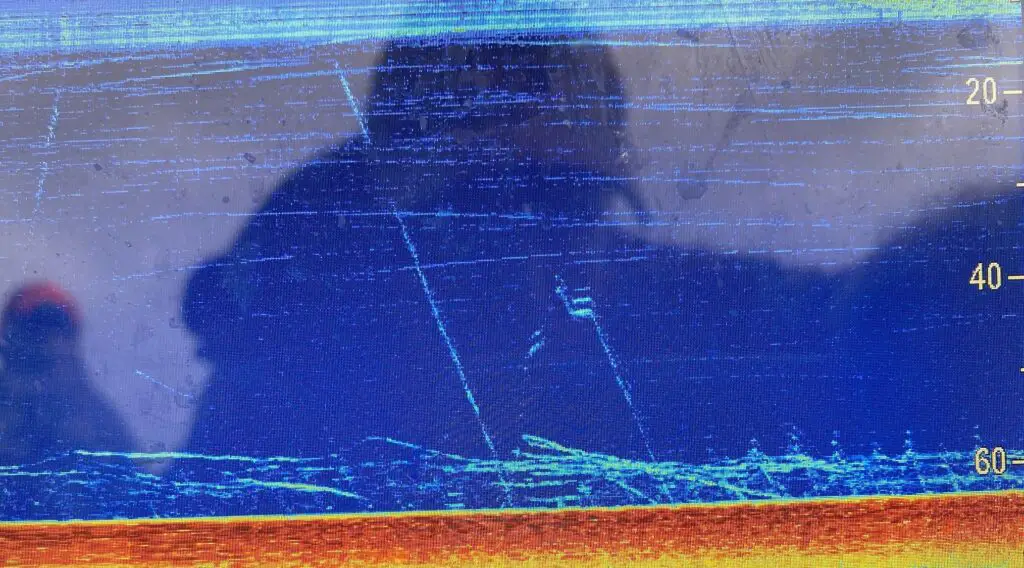
I dropped my setup down to the depth of the squid on the fish finder, gave it a few gentle jigging motions and it was squid on! Squirt squirt!
I dropped right back down there and I felt a much heavier hit on my jigs, I reeled up steadily to ensure the squid stayed hooked on the prongs of the jig and as I lifted them from the water I could see I had the first triple of the night!
I dropped down again, and again it was squid on!
Now…the problem here was that nobody else had hooked a squid yet, and they were looking at me with a mixture of irritation, confusion and admiration for what was happening.
I myself am not 100% sure what the different factors were, but I have a few ideas i will share in this blog post that may help you if you’re a boat squidder looking to repeat this kind of success rate.
At first I thought it was a bit of initial luck, but the action continued this way all night. I’m not about tooting my own horn and bragging just for the sake of it, but I do think it warrants an examination of the gear and approach being used to try and explain the different results.
My squid setup was significantly different from the other setups that were in play.

Here’s that picture again. My setup was the one on the far left. I will show it in more detail.
One factor is that I was the only one using a casting reel with a line counter on it. I compare squid fishing to bottom fishing for rockfish, as there are many similarities.
You want a light enough rod to get the most enjoyment out of the experience and that usually means a spinning rod. And that’s always how I’ve done it as well, until this year.
There’s a ton of fish finder watching in both of these fisheries, and while squid and bottom fish are usually found near the bottom, this is not always the case. Sometimes, with a spinning reel, we are just kind of guessing where in the water columns our stuff is while looking at the fish finder.
But, what if we knew exactly where our squid jigs were? The line-counter I think made a huge difference. There was not so much squid around that it didn’t matter the precision of where we were fishing. In fact some folks hooked zero or 2-3 squid the entire trip. And some of these folks were seasoned squidders with lots of experience on the piers (but less so on a boat).
Another factor may have been the squid jigs themselves. One guy next to me was a squidding pro of multiple decades, and had the best hand made lures, etc. But for whatever reason this setup below still got whacked the most:

And in particular, the bottom end of that with the close chain of 2 squid jigs may have been the difference. Everything else was a single jig, but the additional glow of that chain of jigs may have been a factor.
That chain specifically in a more close up shot looks like this:
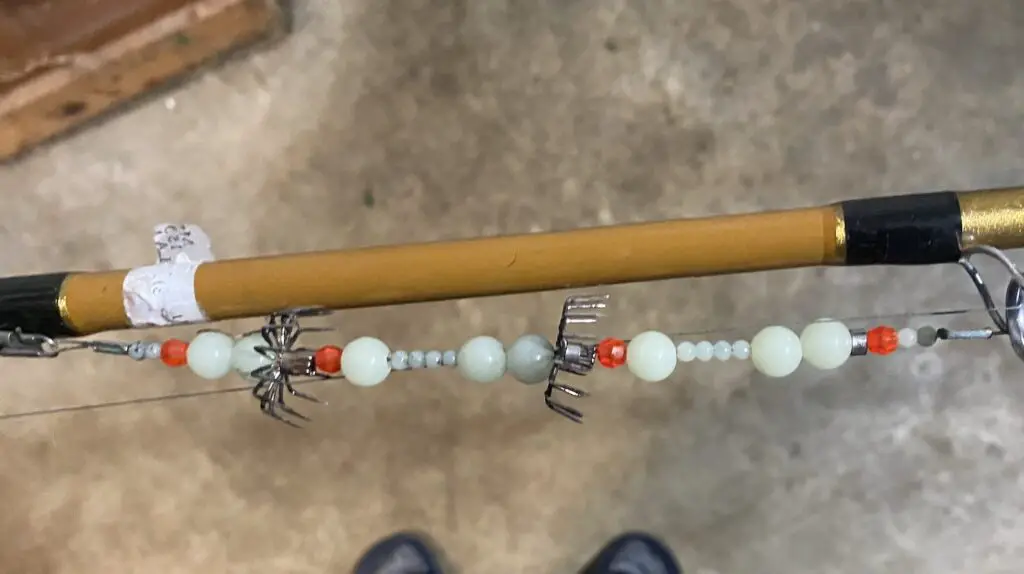
If you look at it critically, you can see that it’s unweighted. That snap swivel at the bottom (left) end of the setup had a 2 or 3 oz cannonball attached to it to provide the weight to get it down and keep it ordered properly (another topic to cover below).
These are the Otori unweighted beaded squid jigs.
The jig on top was probably another standard Otori weighted squid jig.
The line in between was 40 lb flourocarbon of about 14 inches.
A lot of the other setups folks were using had 2 ft between squid jigs, and 20 lb mono, which led to many tangles where the bottom jig gets tangled with the top jig, something that just never happens when you have a cannonball lead attached to the bottom of your setup.
The squidding pro used wire leader between his two jigs and he never tangled either. Squid don’t care!
One of my basic philosophies guiding all my fishing efforts is to keep things simple. Finding fish (or in this case squid) and putting your terminal tackle in front of them consistently is what leads to consistent success as opposed to obsessing over exactly which color, size or brand of whatever.
Tackle makers are in the business of leading you to believe that all of these things matter. But finding your target species, and working your gear the right way takes care of 80% of the success formula.
My squid jigging rod and reel setup
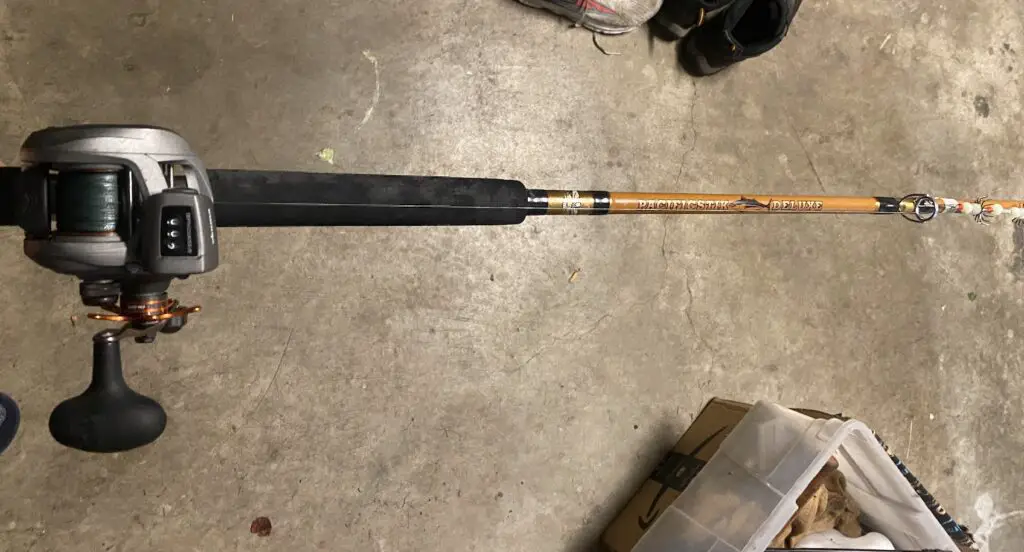
My rod was an older custom setup I inherited from my wife’s uncle, who was an obsessed and quite successful yellowtail fisherman in southern California. The rod has an incredibly sensitive tip that allows me to detect the slightest take of a squid on my jig, but also a backbone that easily handles the 2-3 oz weight dropper weight.
I believe it’s comparable to the below rod I found on Amazon:
My reel was the standard line-counter reel I’ve been buying lately, the Okuma Coldwater low-profile reel.
I’m going to have a few of these setups by next year as I really like how they perform for jigging for bottom fish, salmon and now squid as well!
Looking for more – How-to catch Puget Sound squid resources?
Checkout my video below. Lots of good info in here, but I do need to make a new updated squid video, perhaps that will happen this squid season.